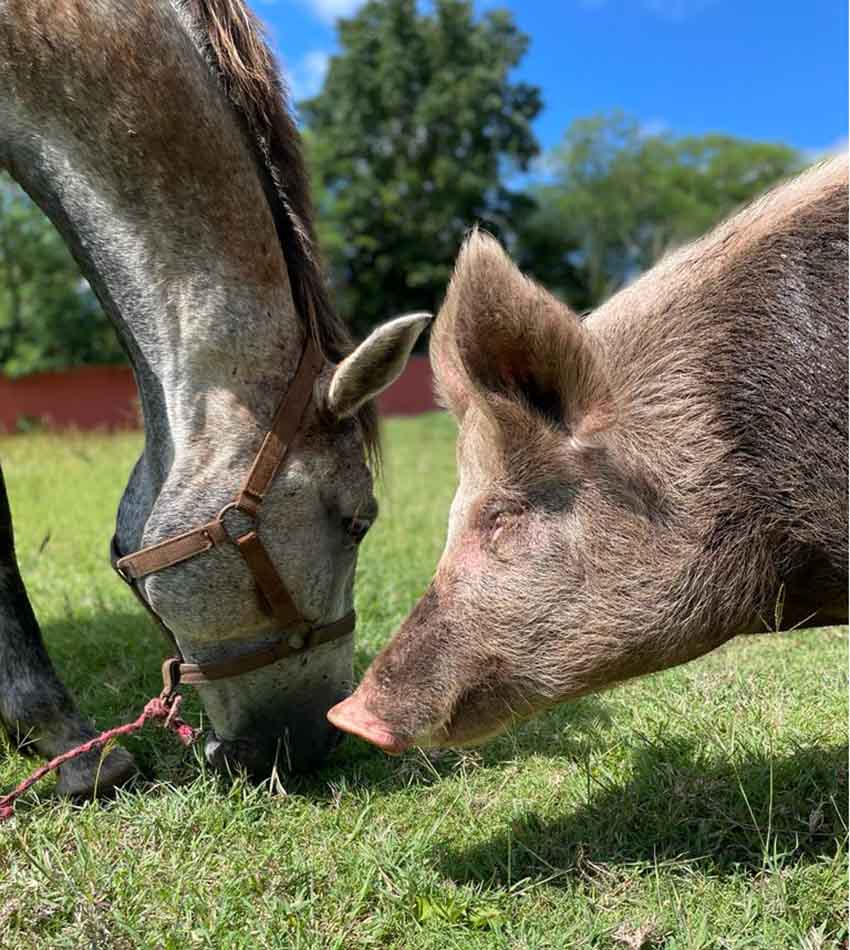When Bakliz’s lifelong owner passed away two years ago, the 21-year-old former cart horse in Campeche ended up living in the kitchen with his master’s widow.
Horse and human spent six months cohabiting in a single room in a situation that unsurprisingly proved untenable for both parties.
He then went to a series of halfway houses, but then Bakliz got lucky: he was taken in by an organization on the outskirts of Campeche city — the Yum Kaax Animal Rescue Centre, a volunteer-run organization that cares for animals of all types and sizes and helps ones that need it back to health. The organization offers some of its residents up for adoption to responsible homes, such as in the case of certain street dogs.
A 21-year-old former carthorse, however, doesn’t generally have an extensive array of second chances, and so two years after he first arrived, Bakliz is one of the most longstanding — and certainly the oldest — of the residents here.
Again, this aging horse is one of the lucky ones. For every animal given treatment and care by a charity group, an uncountable number across the country continue to suffer due to indifference at all levels of society. And when it comes to animal welfare in Mexico, government legislation talks a good game, but common practice continues to verge somewhere between neglect and outright abuse.

An example: infamously, in the state of Campeche, a mass poisoning event of street dogs took place on the malecón boardwalk in 2019, affecting strays but also pets on walks. Scores of animals died overnight in an area well-policed by security cameras, which later were found to have had no recordings of the deliberately laid poison.
Understandably with such a coordinated event, suspicion fell on the state and municipal authorities, with both publicly declaring innocence and blaming the other. Whichever the way of it, in this by-no-means-unusual case, it was the government guardians of animal welfare themselves who were being accused of the killings.
Of course, street dogs in the country are far from a straightforward issue. Mexico has one of the largest populations in all of Latin America, and while this is partially due to irresponsible dog owners, a large part of the problem is lack of education and poor access to sterilization.
As a result, dogs who are allowed to move in and out of houses largely unchecked impregnate, or are impregnated by, dogs who do not have homes.
Where sterilization campaigns for street dogs do exist, they have a tendency to be ad hoc and usually feel like the forgotten extra of a non-policy. Even where such programs do exist, after-care for sterilized animals is virtually nonexistent, save for the efforts of local resident activists.
Sadly, most of these people are unfinanced, irregular and struggling against the sheer scale of the problem at hand, not to mention civic indifference.

Notwithstanding the moral necessity to care for other creatures, it’s also in the interest of the general public, municipal governments and health organizations to develop functioning policies for Mexico’s itinerant animals. The most obvious, yet hardly accepted, rationale for this is because animal welfare is a significant human public health issue in its own right. Taking better care of animal welfare would actually save the taxpayer countless millions of pesos that currently go into attending to dog bites and diseases carried by excrement and related parasites, to name but two issues.
“It’s a problem which multiplies itself,” said Anielka García Villajuana, president of the Patronato de la Ciudad de Campeche. “It can’t be dealt with piecemeal; it needs a concerted governmental drive. At the moment, at the front line of this situation are individual animal lovers and small organizations, but they can’t do this alone.”
Indeed, in some cases, local authorities spend more time opposing these citizen activists than addressing the problem themselves.
In Mérida, for instance, animal rights defenders are currently battling the municipal government over a recent order that prohibits the feeding of animals in the streets. Officials said the regulation was put in place to discourage the presence of animals in the city, as well as to protect the local fauna and the hygiene of the streets. However, critics highlight the irony by seeking to assign penalties to the very people who are regulating street populations through care and sterilizations.
For now, countrywide governments are aware of the problem without any real drive to address the issue holistically. Animals, who are voiceless, get forgotten in the corridors of power.
Part of the problem is legislators’ lack of vision. In the state of Campeche, for example, the Animal Protection Act (1997) — the only real legal vanguard against animal cruelty — only applies to domestic and breeding animals. In forbidding the mistreatment of animals, the law states that it is prohibited to kill any animal by cruel means, including poison and blunt force trauma.

What this means in reality, however, is that chronic domestic mistreatment of animals — difficult to monitor at best and impossible to regulate at worst — is left unchecked, and animals outside of the domestic sphere, i.e., stray dogs and other wild animals, are frequently subject to abuse with absolutely no repercussions.
It’s a familiar theme, but that makes it no less distressing: a society that allows abuse to occur in plain sight in any context is unavoidably generating future generations of people inured to the impact of violence against animals.
In the great struggle for the future of Mexico’s soul, a little more animal love and respect would pay widespread dividends long into the future.
Shannon Collins is an environment correspondent at Ninth Wave Global, an environmental organization and think tank. She writes from Campeche.
